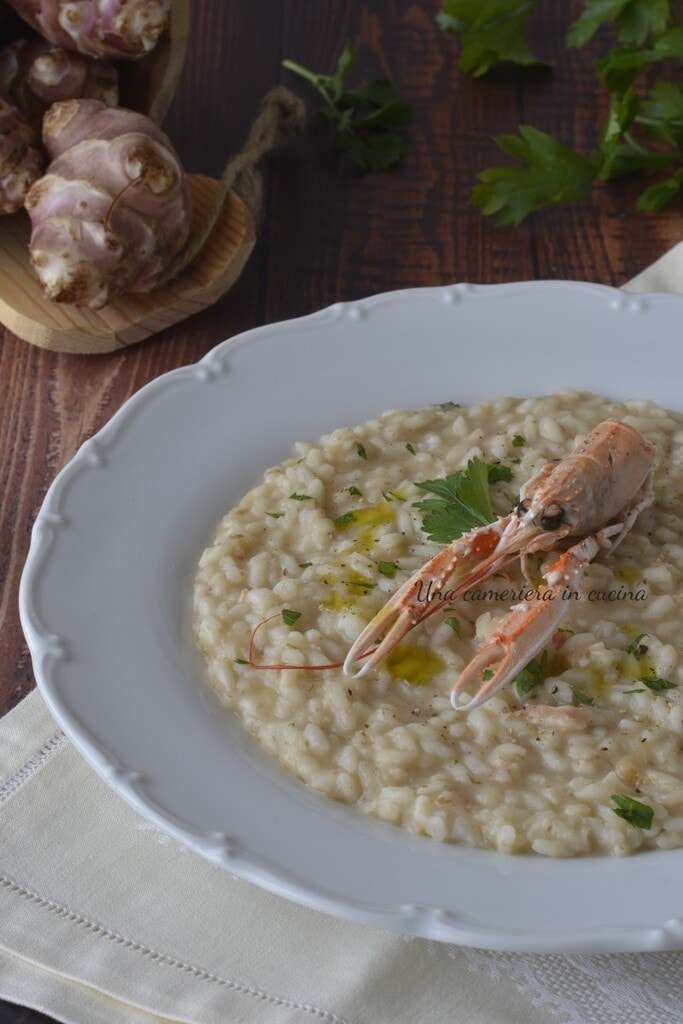The risotto with langoustines and Jerusalem artichoke cream is a delicious first course, elegant to serve especially on big occasions such as Christmas holidays. With a delicate flavor, this risotto is prepared with a simple Jerusalem artichoke cream, a tuber similar to a potato with a flavor reminiscent of artichoke, and langoustines lightly sautéed in a pan. Everything is deglazed and flavored with the langoustine bisque, a broth or rather reduction, produced by boiling their scraps which give flavor and color to the risotto.

- Difficulty: Medium
- Cost: Medium
- Preparation time: 1 Hour
- Portions: 3 People
- Cooking methods: Boiling, Stove
- Cuisine: Creative
- Seasonality: Fall, Winter, Christmas
Ingredients
- 2 cups water
- 1 2/3 cups langoustine bisque
- 14 oz langoustines (gross weight, 15 pieces)
- 10.6 oz Jerusalem artichokes
- 8.5 oz Carnaroli rice
- 3 shallots (small)
- 1 lemon
- 1 glass dry white wine
- to taste extra virgin olive oil
- to taste butter
- to taste parsley
- to taste fine salt
- to taste black pepper
- 4 1/4 cups water
- 1.7 oz brandy
- 1.4 oz shallot
- langoustines (scraps)
- to taste extra virgin olive oil
- to taste ice
Tools
- Food Scale
- Knife
- Cutting Board
- Chopper
- Wooden Spoon
- Steel Pot
- Spatula
- Scissors
- 2 Saucepans
- Toothpick
- Fork
- Ladle
- Pan
- Brush
- Bowl
- Lemon Juicer
- Colander
- Gloves
- Food Scale
- Pot
- Lid
- Strainer
- Blender
- Bowl
- Wooden Spoon
Steps
To prepare the risotto with langoustines and Jerusalem artichoke cream…
First, start by cleaning the langoustines. With your hands, detach the head and claws, with scissors remove the tail, cut the shell covering the belly, then carefully with your fingers detach the flesh without breaking it from the rest of the shell. Finally, with a toothpick, remove the black filament which is the intestine. Continue this way with the other langoustines.
Rinse the langoustines under cold running water and set them aside for the moment. Then take the scraps (claws, heads, shells), rinse them too under running water, washing the heads well by emptying them and removing the eyes with scissors.
Peel and slice a shallot then add it to a pot with extra virgin olive oil and lightly brown it. Then add the langoustine scraps and brown them over medium heat, deglazing with the brandy.
When the brandy has evaporated, pour ice and cold water into the pot with the scraps so as to cover them completely. In this way, the cooking will stop and all the flavors of the shellfish will be extracted. Boil everything over medium heat for 30/40 minutes, stirring occasionally and covering with a lid. If necessary, add more water during cooking.
After the bisque boiling time has passed, you can strain everything with a fine-mesh strainer, thus eliminating the scraps and retaining the liquid part, or use both, as I did.
Pour everything into the blender (scraps and liquid) and blend it at maximum power until the scraps are completely finely chopped, obtaining a sort of mush.
Now filter the bisque using a fine-mesh strainer, even better if you have a strainer called chinoise. Repeat the process several times if necessary, then pour the liquid into the pot, you will need it to wet the risotto later.
Meanwhile, as the bisque cooks, prepare the Jerusalem artichokes. Take the Jerusalem artichokes, wash them under cold running water, removing any soil residues with the help of a brush.
In a pot, heat the water to boil the Jerusalem artichokes. While it reaches a boil, wear gloves, cut the Jerusalem artichokes into slices or pieces to cook them faster, and put them in a bowl with water and lemon juice to prevent them from turning brown.
When the water boils, drain the Jerusalem artichokes from the acidulated water and cook them for 10/15 minutes over high heat. Check the cooking by piercing them with a fork.
Then drain the Jerusalem artichokes and put them in the chopper, run it for a few seconds until you get a smooth and homogeneous cream. Now you can prepare the risotto.
In a pot, heat the water that you will need along with the bisque to wet the risotto during cooking.
Peel and chop the shallots, place them in a steel pot with extra virgin olive oil, and sauté them. Then add the rice and toast it.
Also heat the previously prepared bisque. Meanwhile, in a pan with a little extra virgin olive oil, sauté the cleaned langoustines you set aside for a few minutes.
Then deglaze the toasted rice with white wine and let it evaporate. Then start wetting the risotto with both the strained bisque and the hot water. Cook it like a normal risotto for about 20 minutes, wetting it from time to time with both liquids and stirring with a wooden spoon.
Almost at the end of the risotto cooking, add the Jerusalem artichoke cream and the langoustines. You can either use 5 pieces per plate to add as a final decoration or cut them into smaller pieces and pour them directly into the risotto during the final cooking.
Finally, salt, pepper, and plate the risotto, decorating it as desired. Add fresh chopped parsley and a drizzle of extra virgin olive oil. Serve it hot.
Tips
If you are short on time, you can prepare the bisque the day before. Store it in an airtight container in the fridge.
You can replace fresh langoustines with frozen ones after defrosting.
You can replace langoustines with shrimp or prawns, following the same preparation method.
You can substitute Jerusalem artichokes with boiled fennel, although this will change the flavor.
You can substitute Jerusalem artichokes with boiled fennel, although this will change the flavor.
You might need…
Lacor Chino Chef Colino Chinois Strainer, Stainless Steel, Silver, 0.79 Inches

